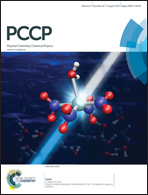Electronic coupling between ligand and core energy states in dithiolate-monothiolate stabilized Au clusters†
Abstract
Electron transfer activities of metal clusters are fundamentally significant and have promising potential in catalysis, charge or energy storage, sensing, biomedicine and other applications. Strong resonance coupling between the metal core energy states and the ligand molecular orbitals has not been established experimentally, albeit exciting progress has been achieved in the composition and structure determination of these types of nanomaterials recently. In this report, the coupling between core and ligand energy states is demonstrated by the rich electron transfer activities of Au130 clusters. Quantized electron transfers to the core and multi-electron transfers involving the durene-dithiolate ligands were observed at lower and higher potentials, respectively, in voltammetric studies. After a facile multi-electron oxidation from +1.34 to +1.40 V, several reversal reduction processes at more negative potentials, i.e. +0.91 V, +0.18 V and −0.34 V, were observed in an electrochemically irreversible fashion or with sluggish kinetics. The number of electrons and the shifts of the respective reduction potentials in the reversal process were attributed to the electronic coupling or energy relaxation processes. The electron transfer activities and subsequent relaxation processes are drastically reduced at lower temperatures. The time- and temperature-dependent relaxation, involving multiple energy states in the reversal reduction processes upon the oxidation of ligands, reveals the coupling between core and ligand energy states.


 Please wait while we load your content...
Please wait while we load your content...